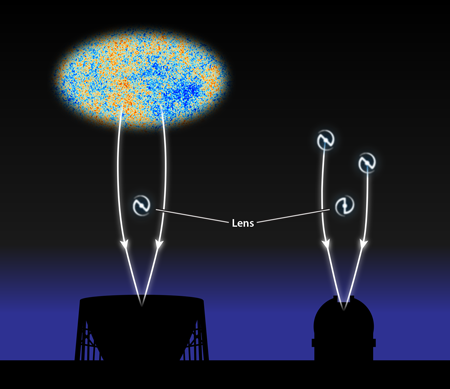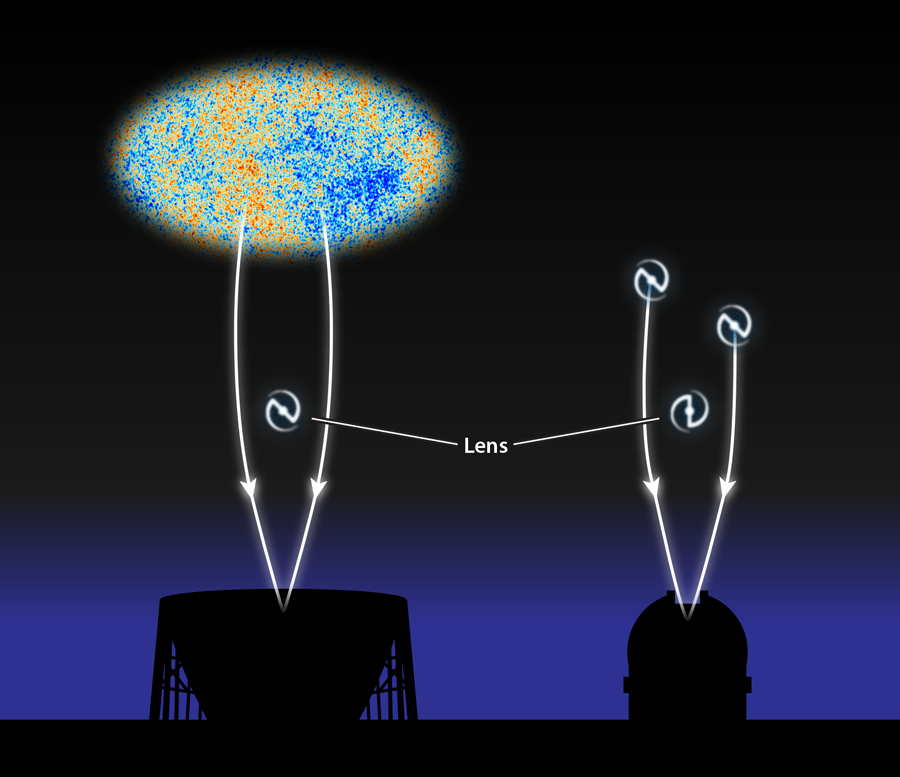Weighing Dark Matter Halos with the Cosmic Microwave Background
Weighing something that is partially invisible is very challenging. But this is exactly what astronomers contend with when estimating masses of galaxies and their clusters. These structures contain significant amounts of still-mysterious dark matter residing in a “halo” extending beyond the standard, baryonic (and mostly luminous) matter. Gravitational lensing allows astronomers to get around this weighing problem. The effect arises when photons emitted by some distant (background) object are bent by the gravitational force of some intervening (foreground) object, known as the lens. Astronomers observe gravitational lensing as a distortion or brightening of the image of the background source, and from that, they estimate the total mass of the lens. Distant galaxies are typically used as the background objects [1], but astrophysicists suggested nearly a decade ago [2] that the cosmic microwave background (CMB) could be a particularly suitable alternative. Mathew Madhavacheril of Stony Brook University, New York, and his colleagues have now put this idea into practice, using high-resolution CMB data from the Atacama Cosmology Telescope Polarimeter (ACTpol) [3]. The team found evidence for gravitational lensing by dark matter halos on the CMB anisotropies and from that derived an estimate of their average mass. With further refinement, this approach could take advantage of the CMB’s ubiquity to provide accurate mass estimates for more objects and at greater distances (higher redshifts) than the background of distant galaxies can do.
The CMB originates from a time when the Universe was very hot and dense and photons were trapped by ionized plasma. This epoch lasted for the first 380,000 years after the big bang and only ended when the overall temperature of the Universe dropped low enough for atoms to form. This process, which is referred to as recombination, freed photons to travel nearly unhindered through space. Some of them have journeyed all the way to our detectors, providing us with an image of the Universe 13 billion years ago. These CMB photons—which were stretched into the microwave region by cosmic expansion—provide a temperature reading of the early Universe, which is very uniform across the sky with only small deviations (hot and cold spots) at the level of 1 part in 105.
However, the CMB image is not a pristine record of the early Universe, as the post-recombination travel of the CMB photons was not truly uneventful. Indeed, the Universe has undergone a huge transformation over the last 13 billion years. Small density fluctuations have grown into a complex web of structures, including galaxies, clusters, and filaments, some of which eventually reionized the gas in the Universe. These changes left an imprint on the CMB photons through, for example, interactions with intracluster plasma (the Sunyaev-Zel’dovich effect), gravitational redshifts, and reionization effects. In addition, CMB photon trajectories were bent by the gravitational pull of structures forming in the Universe, as predicted by Einstein’s general relativity. Studies of this CMB lensing have generated some of the most exciting recent discoveries in the CMB field. Astronomers have detected distortions in the anisotropies of the CMB total intensity [4] but also in the polarization patterns of this radiation [4,5]. CMB lensing has so far been observed on angular scales in excess of a few arcminutes, implying that the lenses in this case are the largest structures in the Universe (i.e., filaments). These recent results have established CMB lensing as a new promising probe of large-scale matter distribution in the Universe.
Madhavacheril et al. [3] complement and extend the analysis of CMB lensing, by studying the effect on smaller, arcminute angular scales, where the lensing objects are either massive galaxies or their groups (clusters). They use data collected by the ACTpol experiment—a telescope with high angular ( 1-arcminute) resolution, operating from a vantage point in the Chilean Atacama Desert. The method involves statistically measuring distortions in the CMB hot and cold spots by the gravitational mass of a foreground object, just as the methods using distant galaxies as the background sources involve distortions in their optical images (see Fig. 1). Using the CMB as the background source offers some interesting advantages over distant galaxies. For one, the time of the CMB’s emission is very well known as are its statistical properties, which helps in quantifying the gravitational distortion. The CMB also comes to us from all directions and can be available for many more objects of interest. Nevertheless, the detected signal has to be disentangled from the other potential post-recombination effects, which may affect the information carried by the CMB photons.
For the time being, the CMB data are still too noisy to showcase fully the CMB lensing potential. The analysis presented by Madhavacheril et al. resorts, therefore, to a stacking technique, averaging together postage-stamp-like images centered at the positions of known galaxies. Nearly 12,000 optically selected galaxies from the SDSS/BOSS survey have been used for this purpose [6]. Once the averaging is done, the resulting map is cross-correlated with different models that describe the distribution of dark matter around galaxies or their clusters. The researchers find that the models with a realistic dark matter halo provide a significantly better fit to the data than models with no dark matter. They estimated the average total halo mass associated with the galaxies used in the stacking process and found it was broadly in agreement with other weak lensing estimates produced using distant galaxies as the background sources [7].
The authors performed several checks to be sure they weren’t seeing a false signal. For example, they modeled potential contaminations due to the thermal Sunyaev-Zel’dovich effect or point sources and quantified how these would affect their analysis. None of these systematic errors explained the data, so the authors contend that they are genuinely seeing the gravitational effects of dark matter halos.
While more work and, in particular, more high-quality data are clearly needed, this first step is encouraging for the prospects of CMB lensing at arcminute scales. Researchers studying the CMB are currently busy trying to detect the primordial large-angular scale B-mode polarization signal. As a by-product, this effort will produce high signal-to-noise maps of the CMB total intensity, and as the ACTpol work demonstrates, these maps may provide their own new and interesting results.
This research is published in Physical Review Letters.
References
- See e.g., J. A. Tyson, R. A. Wenk, and F. Valdes, “Detection of Systematic Gravitational Lens Galaxy Image Alignments - Mapping Dark Matter in Galaxy Clusters,” Astrophys. J. 349, L1 (1990)
- See e.g., U. Seljak and M. Zaldarriaga, “Lensing-induced Cluster Signatures in the Cosmic Microwave Background,” Astrophys. J. 538, 57 (2000); W. Hu, S. DeDeo, and C. Vale, “Cluster Mass Estimators from CMB Temperature and Polarization Lensing,” New J. Phys. 9, 441 (2007)
- Mathew Madhavacheril et al. (Atacama Cosmology Telescope Collaboration), “Evidence of Lensing of the Cosmic Microwave Background by Dark Matter Halos,” Phys. Rev. Lett. 114, 151302 (2015)
- See e.g., K. M. Smith, O. Zahn, and O. Doré, “Detection of Gravitational Lensing in the Cosmic Microwave Background,” Phys. Rev. D 76, 043510 (2007); S. Das et al., “The Atacama Cosmology Telescope: A Measurement of the Cosmic Microwave Background Power Spectrum at 148 and 218 GHz from the 2008 Southern Survey,” Astrophys. J. 729, 62 (2011); A. van Engelen et al., “A Measurement of Gravitational Lensing of the Microwave Background Using South Pole Telescope Data,” 756, 142 (2012); P. A. R. Ade et al. (Planck Collaboration), “Planck 2013 Results. XVII. Gravitational Lensing by Large-Scale Structure,” Astron. Astrophys. 571, A17 (2014)
- D. Hanson et al., “Detection of B-Mode Polarization in the Cosmic Microwave Background with Data from the South Pole Telescope,” Phys. Rev. Lett. 111, 141301 (2013); P. A. R. Ade et al. (POLARBEAR Collaboration), “Evidence for Gravitational Lensing of the Cosmic Microwave Background Polarization from Cross-Correlation with the Cosmic Infrared Background,” 112, 131302 (2014); R. Keisler et al., “Measurements of Sub-degree B-mode Polarization in the Cosmic Microwave Background from 100 Square Degrees of SPTpol Data,” arXiv:1503.02315 (2015); A. van Engelen et al., “The Atacama Cosmology Telescope: Lensing of CMB Temperature and Polarization Derived from Cosmic Infrared Background Cross-Correlation,” arXiv:1412.0626 (2014)
- L. Anderson et al., “The Clustering of Galaxies in the SDSS-III Baryon Oscillation Spectroscopic Survey: Baryon Acoustic Oscillations in the Data Release 9 Spectroscopic Galaxy Sample,” Mon. Not. R. Astron. Soc. 427, 3435 (2012)
- C. Heymans et al., “CFHTLenS: The Canada–France–Hawaii Telescope Lensing Survey,” Mon. Not. R. Astron. Soc. 427, 146 (2012); H. Miyatake et al., “The Weak Lensing Signal and the Clustering of BOSS Galaxies I: Measurements,” arXiv:1311.1480 (2013)





